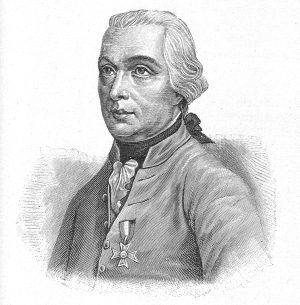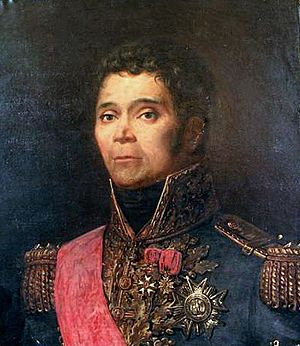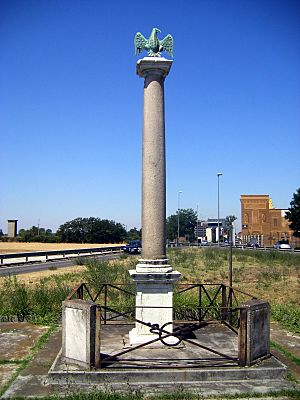Battle of Marengo facts for kids
Quick facts for kids Battle of Marengo |
|||||||
|---|---|---|---|---|---|---|---|
| Part of the Italian campaigns in the War of the Second Coalition | |||||||
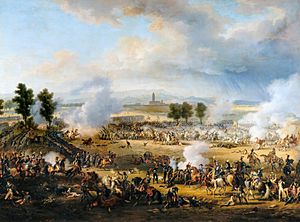 The Battle of Marengo, by Louis-François Lejeune |
|||||||
|
|||||||
| Belligerents | |||||||
| Commanders and leaders | |||||||
| Strength | |||||||
|
Originally : 22,000 men, 15 cannons Total : 28,000 men |
30,000 men, 100 cannons | ||||||
| Casualties and losses | |||||||
| 1,100 killed 3,600 wounded 900 captured |
6,000 killed or wounded 8,000 captured |
||||||
The Battle of Marengo was a very important fight that happened on June 14, 1800. It took place near Alessandria, in Piedmont, Italy. The battle was between French forces led by Napoleon Bonaparte and Austrian forces.
At first, the Austrians launched a surprise attack. They pushed the French back for most of the day. But then, French reinforcements arrived, and the tide of the battle turned. The French managed to win a big victory. This win helped Napoleon become even stronger as the leader of France. It also forced the Austrians out of Italy.
Contents
Why the Battle Happened
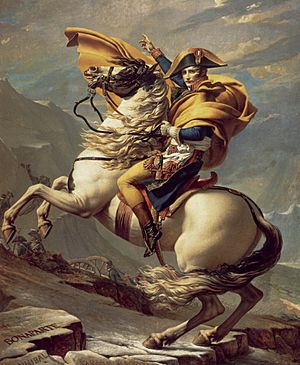
The Battle of Marengo was part of a bigger plan by Napoleon to take control of Italy. In May 1800, Napoleon led his army over the Alps mountains. This was a very difficult journey, as the passes were barely open. His goal was to cut off the supply lines of the Austrian army in northern Italy.
The French army quickly captured important cities like Milan and Pavia. This stopped the Austrians from getting supplies from the east. Napoleon thought the Austrian general, Michael von Melas, would be busy with the siege of Genoa. But Genoa surrendered on June 4, which freed up many Austrian soldiers.
On June 9, French General Jean Lannes won a battle at Montebello. This made Napoleon very confident. He believed the Austrians would retreat and not attack. However, the Austrians were planning a surprise attack of their own.
Austrian Plans and French Moves
The Austrians wanted to fight their way out of their position. They tried to trick Napoleon into thinking they would go north. They used a spy to tell Napoleon to march in a certain direction. This would allow the main Austrian army to attack the French from the side.
Napoleon didn't know exactly where the main Austrian army was. Because he thought the Austrians might try to escape, he spread his own army out. He sent some troops south and others north. This made his main army weaker than it should have been.
On June 13, French forces captured Marengo village. This seemed to confirm Napoleon's idea that the Austrians were retreating. But the Austrians were actually preparing for a big attack across a nearby stream called the Fontanone.
The Battlefield
The battle took place on a flat plain east of Alessandria. A river called the Bormida flowed through it. The Austrians had built bridges over this river.
There were many small villages and farms on the plain. These places were important for controlling the area. The three main spots in the battle were Marengo, Castel Ceriolo, and San Giuliano Vecchio. A small stream, the Fontanone, was between Marengo and the Bormida river. Napoleon set up his main command post at Torre Garofoli, a bit further east.
Comparing the Armies
At the start of the battle, the Austrians had about 30,000 soldiers and 100 cannons. The French had fewer troops, about 22,000 men and 15 cannons. Later, French reinforcements arrived, bringing Napoleon's army to 28,000 men.
The Austrian army had been fighting for a long time and was tired. Many soldiers were sick or had been hurt. It was hard for them to get new soldiers and supplies. The French army, on the other hand, had been reorganized by Napoleon. They had better food and uniforms. Napoleon's army was known for being fast and aggressive.
The Battle Begins
Austrian Surprise Attack
The Austrian attack started around 6 AM. Their troops had to cross two bridges over the Bormida river, which slowed them down. The main attack didn't fully begin until 9 AM.
The Austrians pushed back the French outposts. Their right side moved south, while their center advanced towards Marengo village. On the Austrian left, troops moved towards Castel Ceriolo, threatening to surround the French.
The French soldiers defending Marengo fought bravely. They held off the Austrians for a long time, even though they were outnumbered. The Austrians attacked Marengo several times, but the French held their ground.
General Melas, the Austrian commander, made a mistake. He sent a large group of cavalry away to block a French force that wasn't actually there. This meant those soldiers couldn't help in the main battle.
Holding the Line at Marengo
Napoleon, who was a few kilometers away, realized around 10 AM that this was a real attack, not a trick. He quickly sent orders for his other forces to come and help.
French General Jean Lannes moved his troops to the right side of the French line. The Austrians tried to cross the Fontanone stream and attack the French flank, but they were pushed back by French infantry and cavalry.
By 11:30 AM, the Austrians had taken Castel Ceriolo, putting more pressure on the French right side. Napoleon sent his last reserves, including the elite Consular Guard, to help.
French Retreat and Austrian Advance
Around 12:30 PM, the Austrians launched another strong attack. They managed to cross the Fontanone stream. The French could no longer hold their positions and began to fall back. By 2:30 PM, Marengo village had fallen to the Austrians.
The French army was forced to retreat about 3 kilometers. They tried to regroup at the village of San Giuliano. The battle seemed almost won for the Austrians. General Melas, who was slightly wounded and 71 years old, handed over command to his chief of staff.
The Austrians formed a large column to chase the French off the battlefield. However, their army became spread out. Some Austrian troops went off to chase a small French group, taking them out of the main fight. Other Austrian forces hesitated, giving the French a chance to recover.
The French Counter-Attack
Just when things looked bad for the French, General Louis Desaix arrived with 6,000 fresh troops and 9 cannons. He had been sent south earlier but rushed back when he heard the battle was going badly.
When Napoleon asked Desaix what he thought, Desaix famously replied: "This battle is completely lost. However, there is time to win another."
The French quickly brought up Desaix's fresh troops. They surprised the leading Austrian column. As the Austrians advanced, French cannons fired grapeshot at close range, causing a lot of damage. Then, in a key moment, French cavalry led by General François Étienne de Kellermann charged the Austrian grenadiers from the side. This caused the Austrian line to break apart.
Sadly, Desaix was shot and killed during this charge. But his arrival and the powerful cavalry attack turned the battle around. The Austrian troops panicked and fled back towards Alessandria. Many were killed, wounded, or captured.
The French chased the retreating Austrians. The Austrians lost about half their army, including 15 flags, 40 cannons, and 8,000 prisoners. The French had fewer losses, about 4,700 killed or wounded. They had won the battle and gained a huge advantage.
After the Battle
Napoleon needed to return to Paris quickly. The day after the battle, the Austrians agreed to stop fighting in Italy. This agreement was called the Convention of Alessandria.
The victory at Marengo made Napoleon much more powerful as the leader of France. It showed that he was a great military commander. He used this victory to strengthen his control over France and begin making big changes.
How the Story Was Told
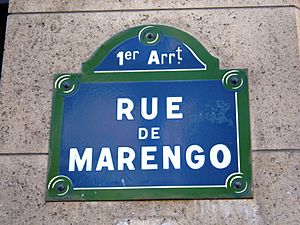
Even though the battle was almost lost, Napoleon made sure it was remembered as a great victory. He created special reports that made the battle seem even more glorious than it was. He wanted to be seen as the hero who saved France.
For example, General Kellermann's cavalry charge was very important. But Napoleon's reports tried to give more credit to other units that were directly under his command. This was part of his effort to control the story of the battle.
Some people who were there knew the truth. They said the French army was in a very bad situation for most of the day. They were retreating and almost defeated. But Napoleon wanted the public to believe it was a planned victory.
Marengo's Legacy
Marengo Museum
Today, you can visit the Museum of Marengo, called "Museo della Battaglia di Marengo." It's located in Spinetta Marengo, Alessandria, where much of the fighting happened. The museum is part of Villa Delavo and includes a park around the village.
Remembering the Battle
Napoleon wanted to make sure his victory was never forgotten. He planned to build a huge pyramid on the battlefield. This pyramid was meant to be part of a "city of Victories" with streets named after battles. However, this big project was never finished.
A column that was put up in 1801 was removed, but it was restored in 1922. Many things were named after Marengo to honor the battle. Several ships in the French Navy were called Marengo. A whole region in France was named the Marengo department.
Even Napoleon's favorite horse was named Marengo. This horse carried him in many other famous battles, like the Battle of Austerlitz and the Battle of Waterloo.
After Napoleon's time, people who moved from France to America named a county in Alabama "Marengo County." Many other places in Canada and the United States are also named Marengo. Today, re-enactments of the battle are held every year.
Chicken Marengo
Did you know there's a famous French dish called chicken Marengo? It was named in honor of Napoleon's victory at this battle!
See also
- Military career of Napoleon Bonaparte



